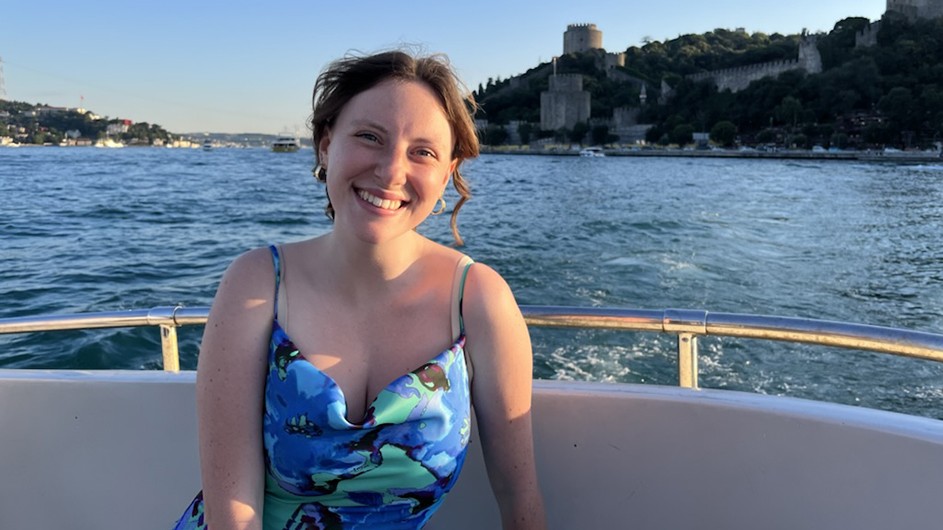Columbia SIPA’s Sadie Brownlee Aims to Help Migrants and Refugees
She hopes to curate a career that blends policy, art activism, and human rights.

Notebook is a Columbia News series that highlights just some of the many fascinating students who study at our University.
As a child, Sadie Brownlee empathized with the stories of migrants and refugees, and decided to pursue a career in refugee advocacy. Her undergraduate work furthered those goals, and now at Columbia School of International and Public Affairs (SIPA), she is concentrating on Human Rights and Humanitarian Policy. In her downtime, Sadie loves to explore all facets of life in New York—from enjoying brunch with friends in the West Village to listening to jazz in Bryant Park and walking through the city’s green spaces.
When are you graduating from Columbia SIPA? What is your degree, and your area of focus?
I am pursuing a Masters of International Affairs with a concentration in Human Rights and Humanitarian Policy, and a specialization in Technology, Media, and Communications. I will graduate from SIPA in the spring of 2025.
What drew you to human rights and humanitarian policy, and what was your path to pursuing graduate work at Columbia?
Ever since I was a kid, I have been passionate about the plight of migrants and refugees, and I wanted a career in refugee advocacy. As an undergrad, majoring in global studies with a concentration in transnationalism, my interest in the migration process and transnational stories grew. After graduating, I moved to New York and interned at the International Rescue Committee (IRC) on the Economic Empowerment team, where I provided grants to recently resettled refugees. My role at IRC showed me how the difficulties refugees face are often due to systemic barriers within the national refugee regime.
Acknowledging this, I decided I wanted to address immigration policy to make a substantive difference in the lives of refugees. When looking for graduate programs, I loved that Columbia SIPA had a robust Human Rights and Humanitarian Policy program, renowned faculty, and connections to the most influential human rights institutions in the world. I believed that SIPA would equip me to achieve my goals in the policy world, and that my cohort would inspire me with their diverse backgrounds and perspectives.
As co-president of the Migration Working Group at Columbia SIPA, what does the group do, and what role do you play?
The Migration Working Group seeks to foster curiosity about migration issues around the world and empower students to make a positive difference in the lives of those around us. My vision for the group is one where passion is mobilized and action is informed. My role involves planning and coordinating events with my board, guiding the group’s agenda, and communicating with students and faculty about desired programming. I am also developing an initiative that would feature migrant stories through art installations around the Columbia SIPA building, in an effort to infuse more art and creativity into the space.
How do you like studying in New York? What are your favorite urban activities?
I absolutely love studying in New York. I am very much a people person, and I adore living in a city as densely populated as New York, where there are always new people to meet! Some of my favorite activities include walking in Riverside Park, getting brunch in the West Village (my best friends and I are Buvette regulars), stumbling upon jazz in the street and taking the time to listen (Bryant Park is always a good bet), exploring museums, and talking with strangers.
Any recommendations for how to best enjoy the city beyond campus?
Pick a neighborhood you want to explore, and wander aimlessly with no plan. Remain present in the moment, and just take in the sights and sounds around you. Follow crowds of people, and see where they go. Take walks through the green spaces around the city to decompress. Some of my favorites include Riverside Park, Central Park (especially the North Woods), and Battery Park. Find the places and people that make you feel at home, and keep returning to them.
What are your plans after graduation?
My plans change every day, but right now, I’m hoping to find a career working at the intersection of art and human rights. I believe art has the power to captivate audiences and draw their attention to social causes. I would love to curate a museum exhibition featuring migrant stories to draw attention to the migrant crisis right here in New York, or facilitate programs that promote art for activism.